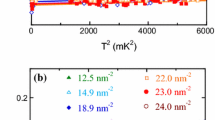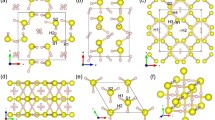Abstract
The specific heatC(X, T) of quench-condensed films of H2 has been measured as a function of ortho concentration X with 0.28<X<0.75 for coverages between 24.3 and 92.3 Å−2 at temperatures between 0.4 and 3.0 K. The films were condensed on evaporated gold substrates held at several temperaturesT. cond between 1.0 and 3.5 K. The observed specific heat is attributed to orientational ordering of the ortho-H2 molecules. For the films withX = 0.74 condensed atT cond>2.5 K, there is a peak which indicates a bulk-like ordering transition. At temperatures below the peak, there is a large contribution toC, which is not present in bulk H2, and which we attribute to short-range ordering size effects. AsT cond is decreased below 2.5 K, the shape of the specific heat curve changes, and the peak at 1.5 K is replaced by a gradual rise with a sharp drop above 2.6 K. Despite this strong dependence ofC onT cond, the entropy per molecule at 3 K is only weakly dependent onT cond and comparable to that for bulk H2. Film annealing at 3.4 K produces a change in the specific heat curve, and a study of this effect is presented. The ortho-para conversion rate of the films condensed at the various temperatures is found to be same as in bulk, well-annealed H2. As in bulk H2, the transition temperature inferred from the location of the specific heat peak or anomaly decreases withX. Unlike in bulk H2, there is no temperature hysteresis inC for any of the quench-condensed films. This implies that the ordering transitions are not accompanied by a martensitic transformation.
Similar content being viewed by others
References
I. F. Silvera,Rev. Mod. Phys. 52, 393 (1980).
R. W. Hill and B. W. A. Ricketson,Philos. Mag. 45, 277 (1954).
G. Ahlers and W. M. Orttung,Phys. Rev. 133, 1642 (1964).
A. F. Schuch, R. L. Mills, and D. A. Depatie,Phys. Rev. 165, 1032 (1968).
J. F. Jarvis, H. Meyer, and D. Ramm,Phys. Rev. 178, 1461 (1969).
R. Wanner, H. Meyer, and R. L. Mills,J. Low Temp. Phys. 13, 337 (1973).
R. Banke, M. Calkins, and H. Meyer,J. Low Temp. Phys. 61, 193 (1985).
W. N. Hardy, I. F. Silvera, and J. P. McTague,Phys. Rev. B 12, 753 (1975).
A. B. Harris, S. Washburn, and H. Meyer,J. Low Temp. Phys. 50, 151 (1983).
J. V. Gates, P. R. Ganfors, B. A. Fraas, and R. O. Simmons,Phys. Rev. B 19, 3667 (1974).
N. S. Sullivan, M. Devoret, B. P. Cowan, and C. Urbina,Phys. Rev. B 17, 5016 (1978).
A. B. Harris and H. Meyer,Can. J. Phys. 63, 3 (1985).
R. J. Roberts and J. G. Daunt,Phys. Lett. 33A, 353 (1970).
N. S. Sullivan, C. M. Edwards, Y. Lin, and D. Dzou,Can. J. Phys. 65, 1463 (1987).
P. Leiderer and U. Albrecht,J. Low. Temp. Phys. 89, 229 (1992).
U. Albrecht, P. Evers, and P. Leiderer,Surface Science 283, 419 (1993).
R. N. J. Conradt, U. Albrecht, S. Herminghaus, and P. Leiderer,Physica B 194–196, 679 (1994).
A. D. Migone, A. Hofmann, J. G. Dash, and O. E. Vilches,Phys. Rev. B 37, 5440 (1988).
J. Classen, K. Eschenröder, and G. Weiss,Annalen der Physik 4, 1 (1995).
R. B. Phelps, J. T. Birmingham, and P. L. Richards,J. Low Temp. Phys. 92, 107 (1993).
T. W. Kenny and P. L. Richards,Phys. Rev. Lett. 64, 2386 (1990).
T. W. Kenny and P. L. Richards,Rev. Sci. Instrum. 61, 822 (1990).
L. Duband, A. Lange, and A. Ravex,Proc. 4th European Symposium on Space Environmental and Control Systems, Florence, Italy (ESA SP-324, Paris), p. 407 (1991).
Quartzdyne, Inc., Salt Lake City, UT 84123.
E. E. Haller, N. P. Palaio, M. Rodder, W. L. Hansen, and E. Kreysa, inNeutron Transmutation Doping of Semiconductor Materials, edited by R. D. Larrabee (Plenum, New York, 1984), p. 21.
MSTF-3-S-N-1K-02, Mini-Systems, Inc., North Attleboro, MA, 02761.
E.-T. H20E, Epoxy Technology, Inc., Billerica, MA 01821.
GR-200A-100, Lake Shore Cryotronics, Inc., Westerville, OH 43081.
P. F. Sullivan and G. Seidel,Phys. Rev. 173, 679 (1968).
807B9852-01-B, Ceramaseal, New Lebanon Center, NY 12126.
SC-102, Maxtek, Inc., Torrance, CA 90503.
SO100, Maxtek, Inc., Torrance, CA 90503.
G. J. Kellogg, P. E. Sokol, S. K. Sinha, and D. L. Price,Phys. Rev. B 42, 7725 (1990).
R. N. Thurston and K. Brugger,Phys. Rev. 133, A1604 (1963).
V. Panella and J. Krim,Phys. Rev. E 49, 4179 (1994).
D. Haase, L. R. Perrell, and A. M. Saleh,J. Low Temp. Phys. 55, 283 (1984).
H. Meyer and S. Washburn,J. Low Temp. Phys. 57, 31 (1984).
N. Steinmetz, H. Menges, J. Dutzi, H. V. Löhneysen, and W. Goldacker,Phys. Rev. B 39, 2838 (1989).
R. E. Allen and F. W. De Wette,Phys. Rev. 179, 873 (1969).
J. Van Krankendonk,Solid Hydrogen (Plenum Press, New York, 1983), p. 306.
T. R. Govers, L. Mattera, and G. Scoles,J. Chem. Phys. 72, 5446 (1980).
M. Weiner and D. L. Goodstein,Phys. Rev. Lett. 50, 193 (1983).
C. Kittel and H. Kroemer,Thermal Physics (W. H. Freeman and Co., New York, 1980). p. 162.
G. Ahlers,J. Chem. Phys. 40, 3123 (1964).
P. Pedroni, H. Meyer, F. Weinbaus, and D. Haase,Solid State Commun. 14, 279 (1974).
A. J. Berlinsky,Phys. Rev. B 12, 1482 (1975).
F. Schmidt,Phys. Rev. B 10, 4480 (1974).
D. Ramm, H. Meyer, and R. L. Mills,Phys. Rev. B l, 2763 (1970).
J. R. Cullen, D. Mukamel, S. Shtrikman, L. C. Levitt, and E. Callen,Solid State Commun. 10, 195 (1972).
A. E. Curzon and A. J. Mascall,Brit. J. Appl. Phys. 16, 1301 (1965).
R. L. Mills, J. L. Yarnell, and A. F. Schuch, 1972,LT 13, edited by K. D. Timmerhaus, W. J. O'Sullivan, and E. F. Hammel (Plenum, New York), Vol. II: Quantum Crystals and Magnetism, p. 203 (1972).
Author information
Authors and Affiliations
Rights and permissions
About this article
Cite this article
Birmingham, J.T., Richards, P.L. & Meyer, H. Specific heat of quench-condensed hydrogen films. J Low Temp Phys 103, 183–208 (1996). https://doi.org/10.1007/BF00755976
Received:
Issue Date:
DOI: https://doi.org/10.1007/BF00755976




